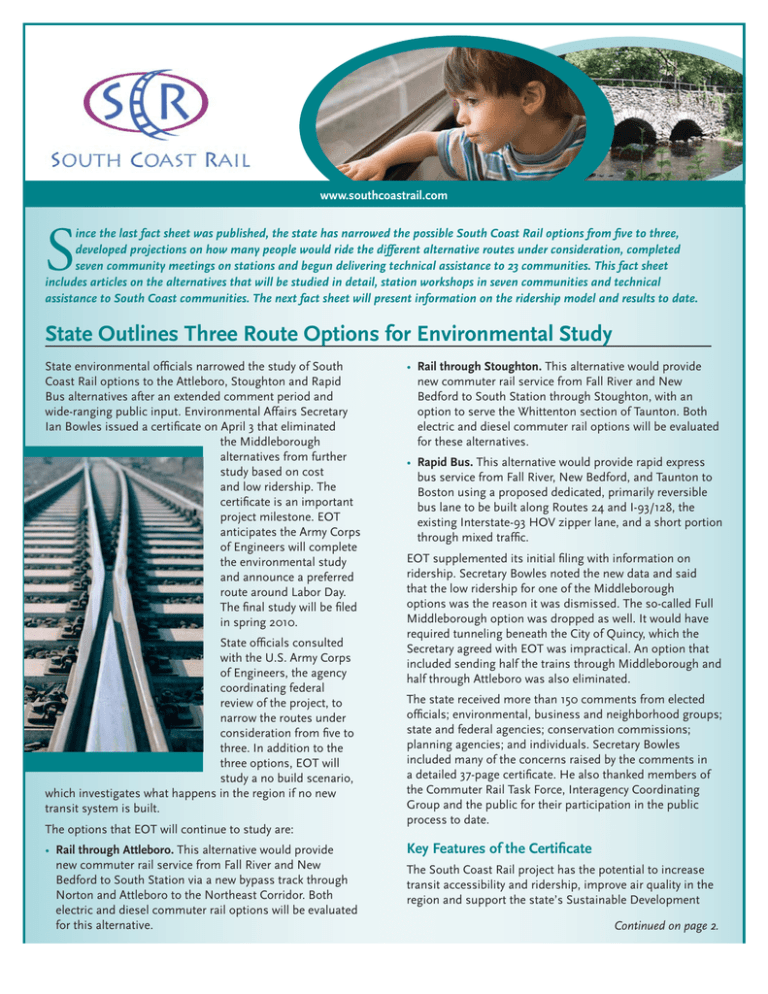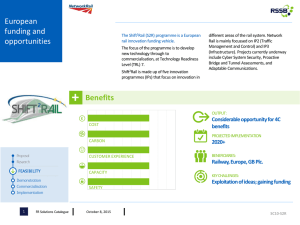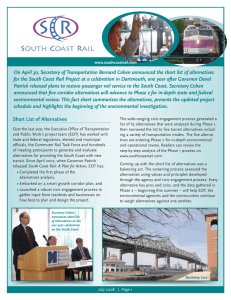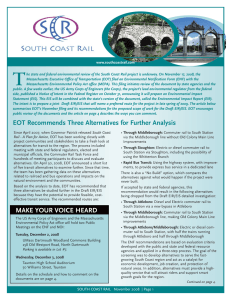S
advertisement

www.southcoastrail.com S ince the last fact sheet was published, the state has narrowed the possible South Coast Rail options from five to three, developed projections on how many people would ride the different alternative routes under consideration, completed seven community meetings on stations and begun delivering technical assistance to 23 communities. This fact sheet includes articles on the alternatives that will be studied in detail, station workshops in seven communities and technical assistance to South Coast communities. The next fact sheet will present information on the ridership model and results to date. State Outlines Three Route Options for Environmental Study State environmental officials narrowed the study of South Coast Rail options to the Attleboro, Stoughton and Rapid Bus alternatives after an extended comment period and wide-ranging public input. Environmental Affairs Secretary Ian Bowles issued a certificate on April 3 that eliminated the Middleborough alternatives from further study based on cost and low ridership. The certificate is an important project milestone. EOT anticipates the Army Corps of Engineers will complete the environmental study and announce a preferred route around Labor Day. The final study will be filed in spring 2010. State officials consulted with the U.S. Army Corps of Engineers, the agency coordinating federal review of the project, to narrow the routes under consideration from five to three. In addition to the three options, EOT will study a no build scenario, which investigates what happens in the region if no new transit system is built. The options that EOT will continue to study are: • Rail through Attleboro. This alternative would provide new commuter rail service from Fall River and New Bedford to South Station via a new bypass track through Norton and Attleboro to the Northeast Corridor. Both electric and diesel commuter rail options will be evaluated for this alternative. • Rail through Stoughton. This alternative would provide new commuter rail service from Fall River and New Bedford to South Station through Stoughton, with an option to serve the Whittenton section of Taunton. Both electric and diesel commuter rail options will be evaluated for these alternatives. • Rapid Bus. This alternative would provide rapid express bus service from Fall River, New Bedford, and Taunton to Boston using a proposed dedicated, primarily reversible bus lane to be built along Routes 24 and I-93/128, the existing Interstate-93 HOV zipper lane, and a short portion through mixed traffic. EOT supplemented its initial filing with information on ridership. Secretary Bowles noted the new data and said that the low ridership for one of the Middleborough options was the reason it was dismissed. The so-called Full Middleborough option was dropped as well. It would have required tunneling beneath the City of Quincy, which the Secretary agreed with EOT was impractical. An option that included sending half the trains through Middleborough and half through Attleboro was also eliminated. The state received more than 150 comments from elected officials; environmental, business and neighborhood groups; state and federal agencies; conservation commissions; planning agencies; and individuals. Secretary Bowles included many of the concerns raised by the comments in a detailed 37-page certificate. He also thanked members of the Commuter Rail Task Force, Interagency Coordinating Group and the public for their participation in the public process to date. Key Features of the Certificate The South Coast Rail project has the potential to increase transit accessibility and ridership, improve air quality in the region and support the state’s Sustainable Development Continued on page 2. Principles, including reducing greenhouse gas emissions. It also has the potential to impact natural resources, wildlife and habitats in the region. To evaluate the balance between the potential benefits and impacts of the project, the certificate outlines detailed investigations that must be included in the draft environmental impact report. Here are some highlights of the requirements: • Each alternative will be analyzed in three scenarios: the baseline condition, without rail or bus; building the alternative without mitigation; and building the alternative with mitigation (including smart growth measures). • Provide more details on the ridership model and the results for each alternative. • Analyze the growth and cumulative impacts – positive and negative – that can result from new housing and economic growth due to new transit. • Study air quality related to fuels, greenhouse gas emissions and around stations; traffic impact studies and mitigation plans. • Detailed environmental studies of wetlands, vegetation, water quality, biodiversity and wildlife habitats, protected open space, public water supplies and fishery resources. • Evaluate benefits and impacts on Environmental Justice populations. • Study impacts on cultural resources; effects of noise and vibration; and evaluate stormwater management measures. The Draft Environmental Impact Statement/ Environmental Impact Report (DEIS/DEIR) will also include responses to the many comments submitted on the environmental filing and ridership memo. The certificate is posted on the project website, www.southcoastrail.com, and print copies are available by request (call or email Charlie Patton, cpatton@reginavilla.com, 617-357-5772, providing your name and address). EOT’s South Coast Rail team will be working closely with the agencies, Task Force and communities over the spring and summer months. The second round of station workshops will be taking place this spring and summer (see article on page 4) and the Smart Growth Corridor Plan will be released in June. Getting Technical The South Coast Rail project is part of a larger initiative of the Commonwealth of Massachusetts to promote sustainable development. To help communities create jobs and build housing in good places while preserving natural areas, the South Coast Rail project is providing technical assistance to communities seeking to advance local and regional goals for smart growth and sustainable development. Eric Hove, Senior Regional Planner at Regina Villa Associates, is helping oversee the development of a Smart Growth Corridor Plan, which includes delivering technical assistance throughout the South Coast. SCR: What is the South Coast Rail’s Technical Assistance Program? Eric: The technical assistance program encourages communities to reexamine their planning and zoning to increase opportunities for economic development and environmental preservation, including protecting open space. The state is providing a range of tools, as well as access to South Coast Rail consultants, to help them develop bylaws and strategies that support smart growth and transit-oriented development. SCR: What are the goals of the program? Eric: The technical assistance program will catalyze real changes in how land is used on a local level. The state is committed to promoting development that is sustainable from both an economic and environmental perspective. Unfortunately, many towns do not have the resources to develop up-to-date zoning bylaws that support the clustering of jobs and housing in places where people already live and work to relieve pressure on our farms, fields and forests. SCR: Describe the process behind the program. Eric: In the fall of 2008, EOT sent letters to the South Coast communities asking them to identify three top priorities for technical assistance. The subject areas included planning for housing and commercial districts, open space preservation and cluster development, low impact development (a technique for Eric Hove and Charlie Patton (left) discuss the priority area map. minimizing stormwater runoff), and sustainable energy. Once the state received the requests from the towns, we balanced these requests with the state’s goals for advancing smart growth. South Coast Rail consultants and regional planning agencies are now helping towns with affordable housing strategies, traffic studies, zoning revisions and more. SCR: What are communities requesting for technical assistance? Eric: The priorities vary by community. Towns that may host a train or bus station in the future are focusing on conceptual plans for the station and transit-oriented development. Many communities are interested in mixeduse development in smart growth locations, protecting critical open space and natural resources. SCR: What are the next steps? Eric: We’ll be finishing this round of technical assistance by June. In the meantime, we will be holding workshops that all communities will be invited to. The workshops will focus on affordable housing strategies and wastewater management. Then, in the fall, after we have a better idea which alternative will be built, we will start working intensively with cities and towns to develop zoning around stations. What are Sustainable Development Principles? Sustainable Development Principles call for new ways of planning development that protect our natural environment while finding ways to welcome and shape new growth. Sustainable development combines transportation, economic development, and environmental goals with old-fashioned frugality and common sense. These principles avoid urban sprawl development that is auto-dependent and wastes natural resources and land. Instead, sustainable development preserves the long-term, global competitive advantages of the whole region — the people who live and work in the region, abundant water, and the traditional village and city patterns of development that are highly energy-efficient. The principles are available at www.mass.gov/smartgrowth. Talking about Stations Over the past three months, EOT’s Kristina Egan and members of the project team have been engaging communities in a series of workshops on the rail and bus station locations in the environmental review process. Station workshops were held in New Bedford, Fall River, Freetown, Taunton, Middleborough, Raynham and Stoughton. The events attracted elected officials, municipal planners, residents and business owners, developers and abutters interested in access and safety. Residents discussed their hopes and concerns regarding potential stations, access, adjacent land uses and development options. The workshops centered on transit-oriented development (TOD) opportunities. Rather than conceiving of commuter rail stations only as regional parking lots, TOD transforms them into places people want to be. Some stations will enhance existing village centers, bringing new life to downtowns, and others will have a more urban feel, with stores, homes and job centers. This kind of development makes station areas a good place to live or work, not just to get on a train. In addition, TOD can increase transit ridership, reduce auto dependency, enhance the local tax base and support local economic development goals. TOD planning in the project corridor will maintain the region’s identity and enrich residents’ lives rather than drastically change them. Development wants and needs vary based on each town’s look, feel and vision for its future. The workshops were crucial for project and town planners to get a sense of what residents and businesses would like to see around their stations. Each station workshop began with a presentation that focused on TOD success stories and examined opportunities within a half-mile and one mile radius of potential stations. Local residents shared their thoughts on access, parking and development for each potential station site. The South Coast Rail team gathered ideas and concerns and will be reacting to these suggestions in its station planning. Later this spring, the team will return to the host communities with station, platform and parking layouts. The Corridor Plan will include vision plans for the station areas, presenting development scenarios for communities to consider. Station workshop minutes and PowerPoint presentations can be found under the reference section of the project website, www.southcoastrail.com. Voices from the Region Let’s listen to some ideas from station workshops in New Bedford and Fall River. We’ll bring you ideas from other communities in our next issue. New Bedford: Make the stations accessible to people who are walking and visiting, as well as drivers. Connect the Whale’s Tooth Station to the neighbors in new housing. Measure success by serving low-income people as well as just increasing transit use. Link new stations to walking trails, housing and commercial activities. Fall River: Cluster activities to revitalize the city center, waterfront and arts district activities; one participant brought his own design on a poster. Include amenities in stations that link them to the city, such as a pedestrian mall or stairway connecting the falls, mills, waterfront and downtown, to enhance Fall River’s Master Planning. Contact Information If you would like more information about the project or to be added to the project distribution list for email and U.S. Mail notifications of meetings and other updates, please contact Kristina Egan, South Coast Rail Manager at EOT, by email at Kristina.Egan@eot.state.ma.us or phone at 617-973-7314. Project information and updates, including a schedule of upcoming meetings, are posted on the project website at www.southcoastrail.com. The Executive Office of Transportation and Public Works Ten Park Plaza, Room 4150 Boston, MA 02116






